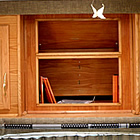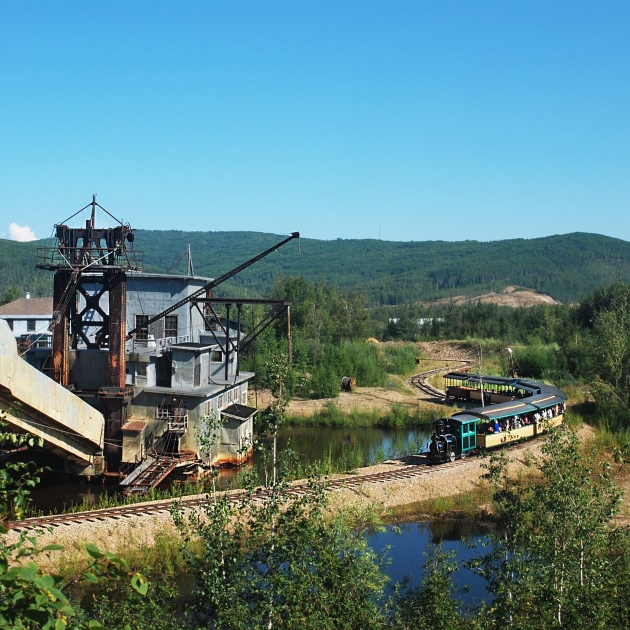Texas has history
Lynne and Fred discover unique attractions, charming communities and rich history in Texas
Up until now, we have avoided spending our winter in Texas but this year we decided to bite the bullet and check it out. For some forgotten reason, we were in a rush to get to Texas so we hit the main highway and flashed through both Mississippi and Louisiana over roads that are suspended mile upon mile above swamps and bayous.
Texans welcome snowbirds and tend to appreciate the boost to their economy that winter escapees, like us, bring. No matter what part of Texas you are in—north, south, east or west—there are vast areas of nothingness with pockets of unique and interesting sights. Our first stop was at Livingston—not far from the Texas/Louisiana border—to check out the Escapees headquarters and a facility they call the Care Center; now that’s an interesting place.
The Care Center is set up as a separate area of the RV park. It is devoted to RVers who, for reasons of health or disability, cannot travel. There is a huge activity centre that houses a variety of activities and it is where meals are prepared and served daily. The residents live in their own RVs on fully serviced sites; they get three meals a day; their laundry is done for them; someone comes in and cleans their places; and they have transportation for medical appointments and such. Even though there is staff on site, most of the work is done by volunteers. The charge for residents is about $800 a month ($1,200 for a couple). The facility and the concept is so unique and empowering for those who can take advantage of it.
Rio Grande Valley or the Gulf of Mexico—that was the question
So where to next? The Rio Grande Valley is very popular as a winter destination for RVers. They tell us there are about 600 RV parks in the area, most of which are considered resorts. They are huge—many between 1,500 and 2,000 sites—and have lots of park model units. They tend to be rather tight communities with people who come back to the same park year after year. The parks have all the facilities, such as swimming pools and golf courses, and every organized activity you could ask for; they are close to the Mexican border, too.
Our choice became the Rockport/Fulton area just north of Corpus Christi. Most of the parks are close to—if not right on—the Gulf of Mexico. All around, there are things to do and see. If you want city stuff, there is Corpus Christi—a smaller city but equipped with everything you might want. The Aransas National Wildlife Refuge is just a few miles away and is the winter nesting grounds for a number of birds, including the whooping crane. For a small centre, Rockport hosts a good number of artists and galleries. There are plenty of fishing opportunities and old missions dot the area, which present great day trips. And of course, there is plenty of seafood and good restaurants. This all fit the bill for us. An added bonus was the weather; there was no snow and only a couple of frost warnings all winter long. The level of humidity was a bit much for us, but then what would you expect from Albertans?
Rockport reminds me of a wannabe tourist destination. There are several new (within the past three years) RV parks; signs advertising lots for sale; and so-and-so estate sites ready to be built on. The signs sit in front of fancy fences and gates but there are no buildings. On the other hand, there are a few rather excessive places that cater to those who enjoy the extreme luxuries of life.
Our routine was to investigate the local areas first and so it was off to the local waterfront in Rockport and the beach. And the birds! Even right in town, the birds have a major presence.
Aransas Wildlife Refuge is a huge area (over 70,000 acres) that was set aside to ensure the protection of breeding grounds for an array of migrating birds and wildlife that I’d never seen before. There is a 16-mile one-way drive through the park that took us an entire day to travel. The outlooks and trails lead off into the marshlands and on a cloudy, rainy day, they can be haunting and at the same time, very tranquil.
There’s a lot of history in Texas. We chose Rockport partly because it is central and we could do all kinds of day trips. Heading north, we visited some of the smaller historic sites like Beeville, Goliad and a small place called Skidmore (Skidmore had a great little Mexican cafe where they fed us authentic food that we had never heard of before). Next, we went to Beeville and saw its historic buildings, then Goliad—which has become quite an artists’ centre and is surrounded by mission sites and the Presidio La Bahia, which was the site of the first action against Mexico in the Texas Revolution.
Mustang Island—Aransas Pass
Aransas Pass is just a few miles south of Rockport where bridges, causeways and finally a ferry take you over to Mustang Island and Port Aransas. The gal at the gift shop in Goliad told us that since Port Aransas started developing as a winter tourist destination, the prices have escalated and many of the artists have moved out and gone to Goliad and Rockport. The beaches there are incredible.
Gaming is illegal in Texas so there are no casinos but Texans are very innovative. There is a casino cruise ship that leaves twice a day from the pier just outside of Port Aransas. They feed you very well while it sails out into international waters, nine miles out into the Gulf, and then the machines are turned on. I’m sure the ship was taken out of regular service at least 20 years ago, but it makes for a fun day trip as long as the weather is calm.
Once you get away from the water and beaches, the terrain tends to be flat, sandy and scrubby. The live oak is the most prevalent form of vegetation. The live oak is interesting in that it takes so many different forms. Growing in sandy soil in a humid climate, it flourishes here. Scrubby live oak (or Texas live oak) bushes are scattered over vast sandy fields. And then there are the forest-like areas that boast huge 1,000-year-old trees.
Next stop: San Antonio
I had mixed feelings about leaving the Rockport area. On the one hand, I was looking so forward to being on the road again but on the other hand, it was so tough to leave all the fine friends we had made over the past six weeks. But it was time to move on and we had heard so much about San Antonio, we just had to go there.
For a city, San Antonio is not bad—if you like cities. The biggest attraction for us was the River Walk that everybody talks about. Apparently, it was always a waterway used by the Spanish to supply water to the various missions in the area. But occasionally it flooded and in the ’20s, after a particularly devastating flood, they decided to do something about it. It wasn’t until the late ’60s that it really came into its own. It’s not unlike the canals in Venice, Italy. It runs for about two and a half miles and all sorts of fancy restaurants, shops, hotel, churches and vendors line both sides of the water. We took a gondola-like boat ride with a great guide who told us all sorts of stories and we got a great view of the whole place. Of course, we stopped and ate at one of the outside cafes.
Then we went out to the Market Square—that definitely is a Mexican market, some things inside but the best was outside. It extends about two good-sized blocks with all types of vendors, restaurants and musicians.
Touring the Texas Hill Country
While we were up that way, we decided to head up into the Hill Country towards Bandera and Fredericksburg. What different terrain we encountered as soon as we started heading north into the hills. These rolling hills are covered with some trees but mostly with bushes. The fields are scrubby, winter-dry and brown. It reminds you that even if the temperature is in the 70s it’s still wintertime.
The area is one huge ranch after another and Bandera is called the Cowboy Capital of Texas. Unique and creative entrances decorate almost every driveway leading up to the ranches. Stone walls often extend on an upward slope from the highway to powerful gateposts and most often the gates are elaborately designed wrought iron with intricate overhead arches depicting the ranch’s name, brand and animals. There must be some kind of competition amongst the ranchers as to who can build the biggest and fanciest entranceway to their ranches.
We went up as far as Fredericksburg, which is a very old German community. It has become fairly touristy with unique little gift shops located up and down the main street. Some of the buildings date back to the mid-1800s and reflect the surrounding rock and stone landscape as well as the Bavarian heritage of the area.
Our major stops were at the Pioneer Museum where we spoke with a 90-year-old tour guide who is a fifth generation Fredericksburger and ate incredible German meals of Wiener schnitzel and “knockers” with sauerkraut.
Moving out of Texas
Both of us really wondered if we would ever make it out of Texas—it goes on and on and on. The farther west we went, the more we saw cacti invading the fields. We still saw some live oak but more mesquite showed up along the way. I felt like I was watching an old Halloween movie with its gnarly, twisted and eerie branches.
Eventually the road turned north and waves of hills emerged against the horizon. The road ripped through each hill, exposing layers of limestone and history built up over eons of wind, water and time.
Then the land was peppered with yucca plants rather than mesquite. Creosote bushes took over and there was desert landscape all around.
Once we reached the Texas border, it was like putting your foot into an old shoe—not exciting but familiar and comfortable. We started on our way to an RV park in New Mexico where we looked forward to the opportunity to visit old friends and revisit treasured places.








